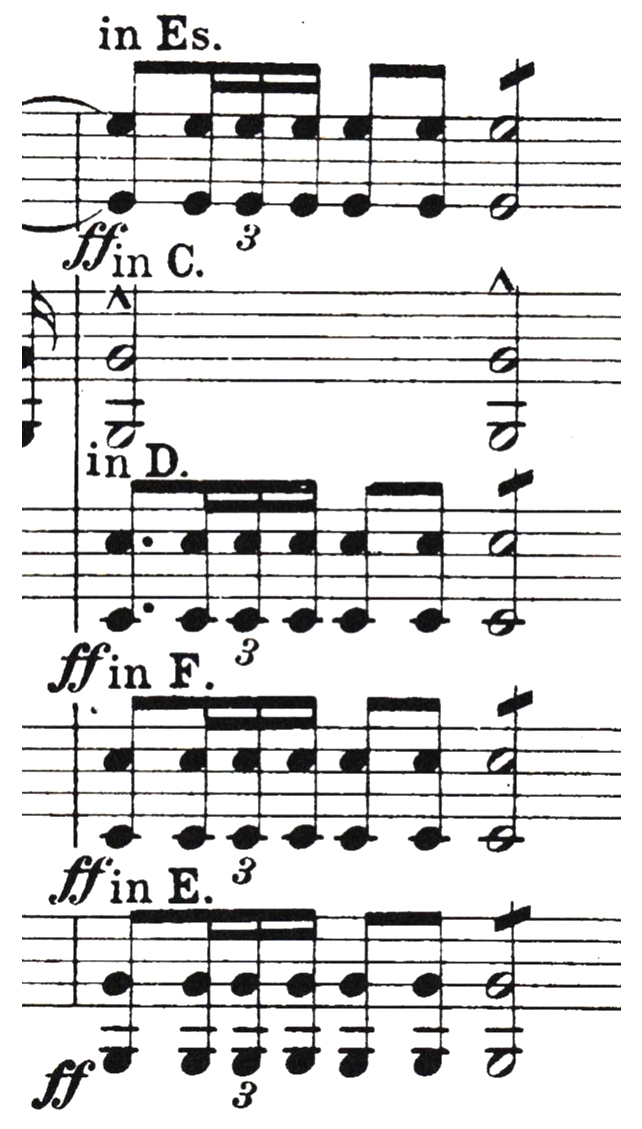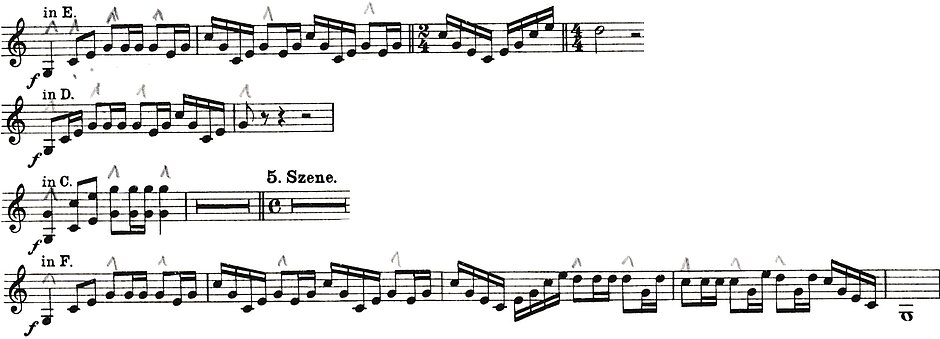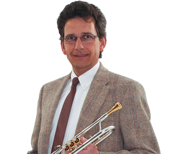Le contenu
- Tips And Tricks For Choosing The Right Transposition
- How come?
- The So-Called "˜Kuhlo System’ Of Trombone Choirs
- How Did All Those Tunings Come About?
- Example: "Lohengrin" by Richard Wagner, Act III, scene 3, stage music: The composer indicated the fundamental tuning for each trumpet part, thus signaling which tuning pipe the players need to install. These indications still appear in orchestral parts, which also means that the key in which the trumpet parts are scored does not correspond with the piece’s key. Trumpet players need to be able to transpose.
- Training - Example: "The Mastersingers of Nuremberg"
- Baroque Music
Tips And Tricks For Choosing The Right Transposition
In German-speaking countries, trumpet students usually start out on a Bb trumpet. Most beginners don’t realize that the difference between the notes they play and the ones they hear is a whole tone.
A written C3 played on a Bb trumpet with no fingering is therefore a Bb3. On a trumpet in A, that note is sounded as an A. In the US and France, beginners usually start out on a C trumpet. The notes they hear therefore correspond to the ones they play.
How come?
The so-called "German Bb trumpet", with rotary valves, is the instrument of choice of renowned orchestras in Vienna, Berlin and Cologne. The reason for this is that they expect a specific sound. Due to the differing air flow inside rotary and Perinet valves, the corresponding trumpet variants have a rather different sound and response.
While trumpets with Perinet valves are usually used in orchestras, valve trumpets"”like the cornet in Bb"”are chiefly used for 19th-century solo pieces. Modern 20th-century compositions are increasingly scored in C, because the so-called "belcanto approach" has gone out of fashion or was even frowned upon, as musicians preferred the more contemporary and leaner sound of a C trumpet.
That is why their parts are scored in C. Most trumpet players know that they need a trumpet in Bb and one in C, because some keys are intricate to play on a Bb trumpet.
The So-Called "˜Kuhlo System’ Of Trombone Choirs
Trombone choirs teach young musicians the transposed approach in C, also known as the "Kuhlo system", which ensures that the notation always corresponds to the notes being sounded: a C3 needs to be played at 1/3, a D3 at 1/2, an E3 at 2, etc. A part scored in C major therefore also sounds in C major, while all "lesser" trombone beginners play a C as "0" and therefore actually produce a Bb. As a reminder: a scored C becomes a Bb.
There are quite a few reasons for this dichotomy. Nevertheless, lots of non-trombonists find it easier to transpose to C and use that system in trombone choirs rather than the other way round. I for my part tend to believe that the underlying function of music is to unite people and to create a common ground. Irrespective of how the differences came about, the separation of church and worldly music should never have happened and simply cannot be justified in our day and age.
I therefore hope that trombone choirs may one day see their way clear to teach their members other tunings in addition to the C tuning to allow them to cross over every now and again.
How Did All Those Tunings Come About?
Bb, C, D/Eb, High-G, High-A/Bb trumpet: what is the reason for all these tunings and, more importantly, are they really necessary? To shed some light on this, let’s go back to the roots.
Long before J.S. Bach’s equal temperament, our ancestors happily blew their natural trumpets, which evolved into long valved trumpets in A, B, C, D, Eb, E, F, G and A# during the 19th century. They offered the possibility to use short tuning pipes to tune them as required. As for French horns and timpani, trumpet parts were usually scored in C (no key signature) but mentioned the required trumpet tuning.
Bach’s equal temperament allowed using one and the same instrument for different keys, which required a change to the instruments’ tuning. Throughout the 19th century, the Low-F trumpet was preferred for its lush sound, which is why lots of parts by the likes of Gustav Mahler are scored in F. In other words, composers relied on what instrument makers were able to build.

Example: "Lohengrin" by Richard Wagner, Act III, scene 3, stage music:
The composer indicated the fundamental tuning for each trumpet part, thus signaling which tuning pipe the players need to install. These indications still appear in orchestral parts, which also means that the key in which the trumpet parts are scored does not correspond with the piece’s key. Trumpet players need to be able to transpose.
Example: "Lohengrin" by Richard Wagner, Act III, scene 3, stage music: The composer indicated the fundamental tuning for each trumpet part, thus signaling which tuning pipe the players need to install. These indications still appear in orchestral parts,
Nowadays, most players use one trumpet with a fixed tuning"”a Bb or C trumpet. Pieces written in the 19th century still contain transposition indications.
This means that trumpet players not only need to master their instrument"”they also need to be extremely good at transposing in real time in much the same way as an interpreter translates what one person says into another language.
This requires a lot of concentration and practice. Not all players are willing and able to do that, and quite a few have taken to transcribing their parts. I am too lazy for that"”and so I need to be good at real-time transposition.

Training - Example: "The Mastersingers of Nuremberg"
The trumpet theme is to sound in D, E, F and C. All parts are scored in C. Since the orchestra’s key also changes, only the transposition needs to be adapted.
Example 1 in E: I use a Bb trumpet. Score written in C, transposition to E.
The Bb tuning lies three whole tones, i.e. a tritone, below the E tuning"”I therefore need to transpose three whole tones up. A C needs to become an F#, and C major changes to F# major. On a Bb trumpet, F# sounds a whole tone lower= E major (C#, F#, A#, C#...).
Example 2 in D: Bb trumpet towards D tuning= transpose a major third up. A part scored in C needs to be played in E major (B, E, G#, B...). Played on a Bb trumpet, a part played in E major actually sounds in D major. Etcetera.
Baroque Music
The key of D major used to be considered funny and martial"”because it allowed composers to score for trumpets. Already J.E. Altenburg admitted that D trumpets were the easiest variant by far, and so a composer’s choice was rather obvious if he wanted trumpets in his composition. Baroque pieces involving trumpets are often in D major.
Nowadays, its is recommended to use a High-Bb/A trumpet developed by Adolf Scherbaum for this key. The indication "high" refers to the fact that the instrument is tuned above the C. The High-Bb/A trumpet, for instance, is one octave above the regular Bb or A tuning. To play a baroque piece in D major using a High-A trumpet, I need to transpose either one fifth down (a~d) or a fourth up (a~d) and drop the part by one octave. Something similar holds for parts in C: on a High-G trumpet, I need to transpose one fourth up and drop the part one octave. This allows me to use the same approach for different instruments.
Make no mistake, though: you will have to transpose at some point. I therefore recommend having beginners practice C transpositions and then work on other transposition intervals. It is a bit like learning a language"”practice makes perfect. How about starting today?


